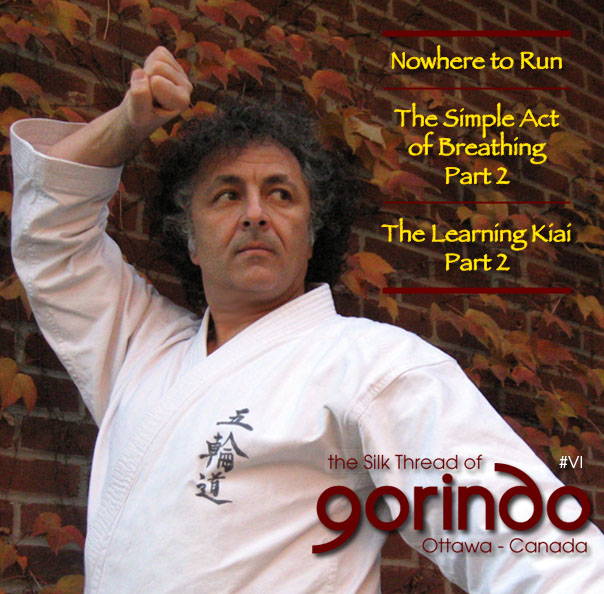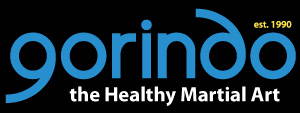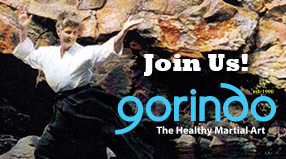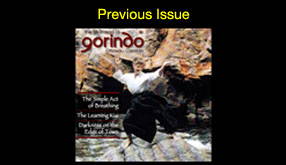
The Silk Thread of Gorindo - Ottawa - Canada
Issue VI
- The Simple Act of Breathing (Part 2)
Photo cover Claudio Iedwab sensei, Gorindo School of Martial Art
The Simple Act of Breathing (Part 2)
< read Part 1 (previous issue)
What is abdominal or diaphragmatic breathing? What does it feel like and how is it obtained?
Breathing passively and quietly through the nose will usually engage only the upper area of the lung, indicated by upper chest rising and often the shoulders lifting. Many teachers describe “breathing from the diaphragm” as the physical process of letting your abdomen rise (when you are in a horizontal position) or extend, keeping the chest still. However, many beginners find this difficult to achieve as they naturally fill their upper lungs first, and then try to “stick their stomach out.” Learning to engage the diaphragm consciously is the key to diaphragmatic breathing.
 If we imagine the body cavity as a jar or vase to be filled (with air rather than water,) we can visualize pouring the air right to the bottom of the vessel and the level rising as it fills. Even more helpful, (and anatomically correct), is a mental image of a balloon with a bulgy bottom that inflates at the base and expands spherically outward in all directions. This expansion is lightly controlled by tension in the abdomen and bymaintaining proper alignment of the pelvis, spine, and head. Feeling that the expansion is occurring across the lower back helps properly position the abdominal cavity, and is part of the therapeutic value of utilizing breathing exercises to those working with body mechanics.
If we imagine the body cavity as a jar or vase to be filled (with air rather than water,) we can visualize pouring the air right to the bottom of the vessel and the level rising as it fills. Even more helpful, (and anatomically correct), is a mental image of a balloon with a bulgy bottom that inflates at the base and expands spherically outward in all directions. This expansion is lightly controlled by tension in the abdomen and bymaintaining proper alignment of the pelvis, spine, and head. Feeling that the expansion is occurring across the lower back helps properly position the abdominal cavity, and is part of the therapeutic value of utilizing breathing exercises to those working with body mechanics.
Control of soft palate
Another factor in how the “balloon” fills, is the shaping of the oral and nasal cavities. The opening and closing of the mouth, holding the teeth clenched, or engaging the soft palate will affect the pressure of the air and the nature of its passage both in and out of the lungs. In exhalation, by closing slightly the soft palate at the back of the nose and throat, a gentle resistance pressure is created at the exit, which both strengthens the diaphragm muscle and allows for control over the movement of air through the passages.
If you think of swallowing or closing the back of the nose when underwater you can close the soft palate. Relaxing the abdominal contraction and then inhaling with open and relaxed throat, will allow the lungs to expand downward, the abdomen expand outwards, and at most we should see the lower floating ribs move with the inhalation and exhalation.
Sitting in seiza
In zazen meditation, the martial artist will concentrate on breathing with a slow measured exhalation. By sitting in seiza (a kneeling position with the spine straight, shoulders and head relaxed, and arms resting comfortably), the student can become more mentally aware of the rhythms of breathing, and the expansion and contraction of the upper body to accommodate the ventilation process.
This exercise is often practiced at the beginning and end of martial art classes as a quiet moment to compose oneself and prepare mentally for the training. The breathing exercise aids in this calming effect. But the principle reason for zazen, especially for beginning martial artists, is to train the breathing mechanism, first consciously and then unconsciously, so that during the more energetic phases of the training, they will still be breathing smoothly and efficiently without having to devote much attention to the process. At more advanced levels of training, zazen meditation provides other benefits, which will be discussed in later chapters.
There are many different ways of breathing, depending on the position and activity of the body. In martial arts, as in zazen breathing, the emphasis is on the abdominal exhalation, yet the pattern of breaths will vary. Particularly in the more vigorous phases of training the intake and expiration of air can be fast or slow, silent or noisy, with tension or relaxation, depending on the requirement of the technique and the task at hand. What is important is the voluntary control of the breathing at the center of the movement, rather than the breathing response limiting what the body and the mind want to do. This is not to say that technique should not flow from the breathing, as this is a fundamental of graceful, strong movement in any activity. But the martial artist trains to strike a balance between the physiological demands of the organism and the intention of the spirit and mind, to best utilize the body’s energy and dynamic resources to achieve its goal.
Kiai: “a joyful noise”
As we naturally emit a grunt or groan when lifting a heavy object, in the same way a martial artist will focus the exhalation of air with a vocal sound into a kiai. The word itself means union of spirit energy, from the Japanese for ki (energy) and ai (union), and therefore represents more than the mere physical manifestation of a shout. For the martial artist in action the term “spirit yell” best describes the source and meaning of the kiai. It is the outward expression and extension of one’s internal energy in union with the body and its external surroundings. The breath is believed to be at the center of this energy, which is both spiritual and physical.
The breath is believed to be at the center of this energy, which is both spiritual and physical.
In Eastern philosophy and health practices, the intrinsic energy of the body is centered in the hara or tanden (an area just below and behind the navel). It is essential that the kiai be formed from air expelled from the deepest area of the lungs and controlled by the abdominal muscles.
The kiai will take on many forms, depending on the task or flow of the moment, such as pulling, pushing, entering or turning. A sharp exhalation kiai is used by martial artists to accompany short percussive strikes, blows, or blocks. A slower more drawn out sound and exhalation would accompany a pushing pulling or extension technique.
Sanchin breathing
This practice is most often associated with the goju-ryu and uechi-ryu styles of Okinawan karate-do (originally from the pangai-noon style of Chinese kempo) and is thought by some to bethe original lessons given by Bodhidharma to the Shaolin monks.
The air and energy is gathered in the hara and then expelled slowly and gutturally with a slight closure of the soft palate at the back of the throat to control the flow of air. It develops great power and emphasizes rootedness and sturdiness, with energy flowing upward from the ground like a tree standing in a storm. The moving tension of the arms and legs forms an isometric pressure zone around the abdominal cavity, allowing the strengthening of the entire body, and developing the use of this strength in a very controlled manner.
In striking and grappling techniques, students are often taught to visualize energy “flowing like water through a hose” in conjunction with their exhalation of air, or to “breathe through their hands.” Breathing exercises, focus on abdominal contraction and the controlled exhalation of the breath during the performance of techniques is central to the daily training in the martial arts.
Excerpt from “The Secret Art of Health & Fitness – Uncovered from the Martial Arts Masters” by Claudio Iedwab & Roxanne Standefer
- The Simple Act of Breathing (Part 2)
« Click the Subscribe link on the left



